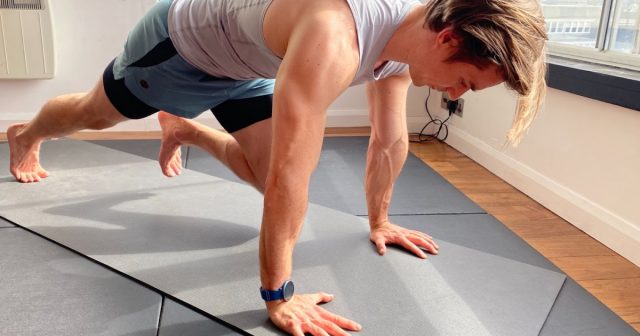Advanced metrics and data was once something only professional athletes with access to cutting edge technology and a team of medical experts were able to benefit from. Thankfully, advancements in technology have made receiving data like heart rate variability (HRV) more accessible than ever.
These days, it’s easy to check the health of your cardiovascular system and progress (or lack thereof) being made with your current training plan. Whether you’re a runner, cyclist, or fitness enthusiast, it’s important to understand how heart rate variability can be used to your benefit. So here is HRV explained – the how and why of tracking this metric.
What is heart rate variability?
While heart rate refers to the number of times your heart beats per minute, heart rate variability (HRV) measures the time between each heartbeat. Also known as an R-R interval, this beat-to-beat interval variation is measured in milliseconds and can vary depending on a number of factors.
For instance, the interval between heartbeats is generally longer on your exhales and shorter when you inhale. So even if your heart rate is 60 beats per minute, the time between these beats is rarely one exact second. Within the same minute, you could have a 0.8-second interval between one set of heartbeats and then a 1.13-second interval between another set.
This probably seems overly scientific and perhaps not that useful for the everyday amateur athlete. However, being able to answer the question ‘what is HRV?’ can in fact provide you with important information about your overall health and the progression of your current training plan.
There are a variety of factors that can influence or change your HRV metrics. These include:
- Respiration
- Exercise volume and intensity
- Rest and recovery from workouts
- Hormones
- Metabolism
- Chronic health conditions
- Stress
- Sleep habits and quality of sleep
- Diet
- Age and gender
- Genetics
Another reason for this great variance in heart rate is because of our nervous system. Your parasympathetic nervous system receives input from your organs, which can cause a decrease in your heart rate. On the other hand, your sympathetic nervous system reacts to outside factors like exercise and stress and can increase your heart rate.
These simultaneous signals that two branches of our nervous system send to our heart cause it to constantly fluctuate, directly influencing your heart rate variability numbers.
What is the average heart rate variability?
As we have seen, heart rate variability can depend on a number of different factors. This makes it a highly individualized metric that can be difficult to compare from person to person. Instead, monitoring this data for trends in your own heart rate variability baseline metrics can be more useful.
That being said, high heart rate variability numbers can be an indicator that your heart is functioning well, adapting to environmental stressors, and seeing an increased level of fitness. Keep in mind though that this metric can be sensitive, and fluctuate from one day to the next.
In general, younger people tend to have higher HRV numbers than older people, males will often have higher numbers than females, and elite athletes will have higher numbers than just about everyone else.
WHAT DOES LOW HEART RATE VARIABILITY TELL YOU?
Your general health and wellbeing have a strong influence on your lifespan, happiness, and quality of life. Keeping track of your heart rate variability metrics can provide surprising insights, such as tracking your fitness levels or understanding how outside factors could be having a negative impact.
For example, poor nutrition, insufficient sleep, illness, or an increase in stress could all cause your HRV numbers to lower. By monitoring this metric, you can make adjustments as needed to address these issues so that your health does not begin to decline.
Poor nutrition, insufficient sleep, illness, or an increase in stress could all cause your HRV numbers to lower.
For runners, cyclists, or fitness enthusiasts, heart rate variability can help you track the progression of your training. This includes how rested you are from a workout and how well your body will be able to tolerate another hard session.
A good example of this is how low heart rate variability often occurs after a hard or strenuous workout. With proper rest and recovery, you should see your numbers rise again in a day or two – an indication that you are ready for another hard workout.
As you gain cardiovascular fitness, you should start to see your heart rate variability slowly improve. If you still have a low HRV metric, it could be an indication that you’re not getting enough rest and recovery, or need to adjust your training plan. Using this metric to your advantage can help you train more efficiently and get the most out of your fitness regimen without risking injury or illness.
How to use a Heart Rate Variability monitor
Thanks to technological advancements, you no longer need a specialized laboratory or a medical professional to measure and analyze your heart rate variability data. A quality heart rate monitor, such as the Polar Vantage V2, will provide all the HRV tracker information you need – alongside information about your calories, sleep, heart rate, and other data related to your workout.
To get the most accurate Polar HRV reading possible, you’ll also need a heart rate strap and the Polar Flow app. With these HRV testing tools, your data can be measured by completing an Orthostatic Test on your Polar device.
Using a HRV monitor will detect any changes in your autonomic nervous system by calculating your heart rate, heart rate variability, and sleep quality, while also factoring in things like stress levels and environmental changes. Once analyzed, your data will be displayed on the Polar Flow app for you to keep track of.
Since heart rate variability data can be sensitive, it’s best to conduct the test regularly at the same time of day. Taking the test first thing in the morning is generally recommended for this reason, and can be a good way to gauge how recovered you are before the day begins.
Once you have baseline numbers, it’ll be easy to recognize any trends that might need to be addressed. Steadily rising numbers will indicate progress in your fitness, while a decline or sudden dip from your normal averages may highlight a need to address an underlying issue such as sleep or stress.
TIPS TO IMPROVE HEART RATE VARIABILITY
Improving your cardiovascular health, endurance, and heart rate variability all go hand in hand. For those looking to improve this metric for health or performance reasons, here are some basic tips you can use to improve your heart rate variability metrics.
Schedule recovery days
Training hard on too many consecutive days without a day of rest or recovery can leave your body feeling run down. For this reason, schedule active recovery workouts or recovery days following a hard block of training.
Make hydration a priority
Being hydrated can improve circulation and make it easier for your blood to deliver oxygen to the body. This can have a direct impact on your training, health, and overall stress.
Get serious about nutrition
Did you know that alcohol can affect your heart rate variability for as long as five days? Poor nutrition can also have a similar effect on your data and impact how your body feels while working out.
Be consistent
Your body will adapt to your training load more easily when you’re consistent. This can involve things like working out at the same time of day, having a set sleep schedule, and avoid those random binge nights with junk food on the weekends.
If you liked this post, don’t forget to share so that others can find it, too.
Or give it a thumbs up!
I like this article
Please note that the information provided in the Polar Blog articles cannot replace individual advice from health professionals. Please consult your physician before starting a new fitness program.





